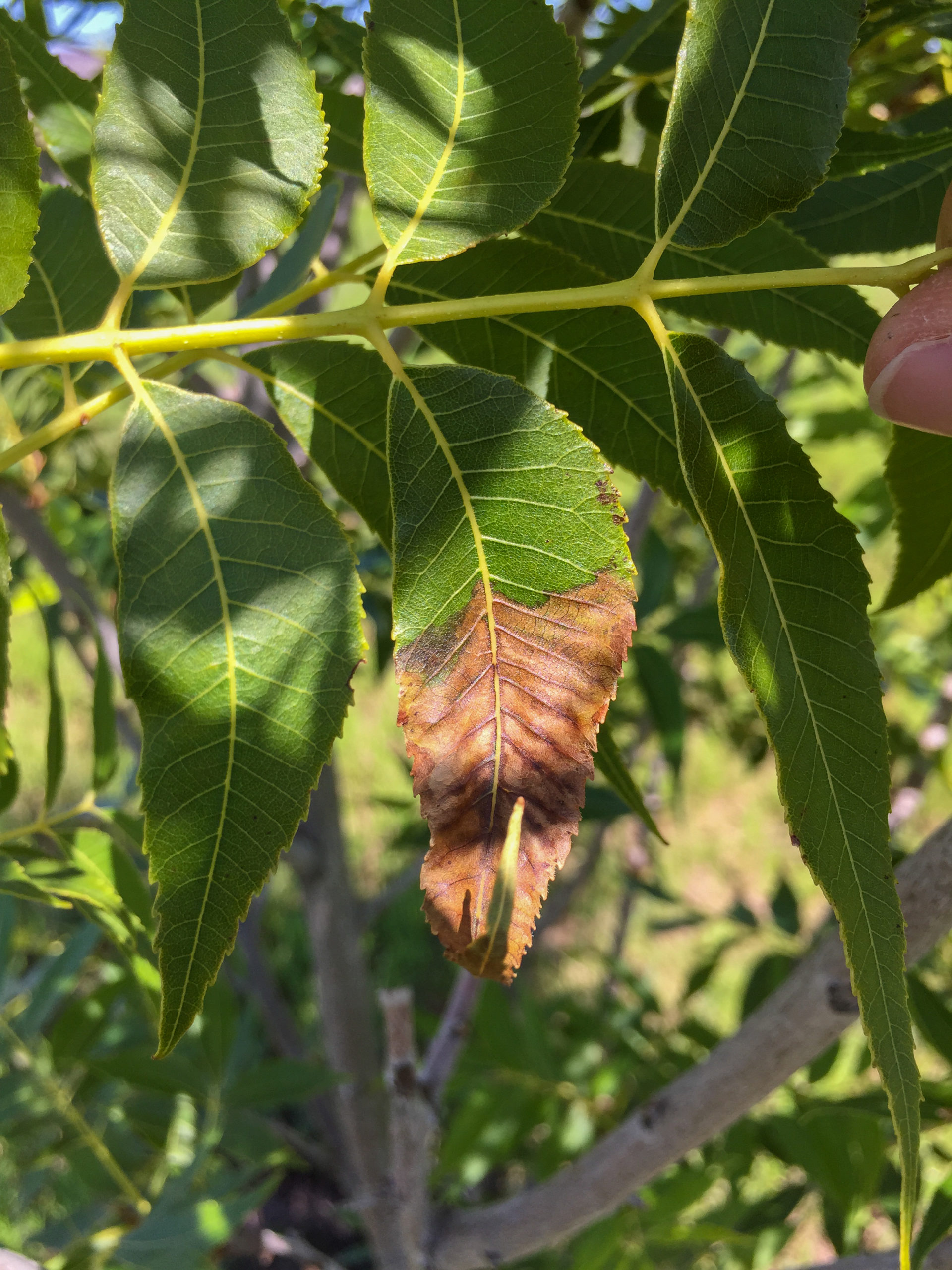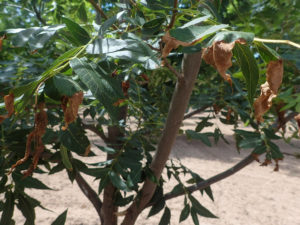Improved detection of Xylella fastidiosa in pecan
Newly researched and improved detection methods for Xylella fastidiosa provide additional support for diagnosing this bacteria in pecan.

Pecan Bacterial Leaf Scorch on a mature pecan tree in New Mexico. (Photo by Natalie Goldberg, New Mexico State University. Used with permission.)
The subspecies X. fastidiosa (multi), or Xfm, that causes pecan bacterial leaf scorch can also infect many tree species, including oaks, American sycamore, peaches, plums, almonds, and maples. X. fastidiosa (multi) survives inside the plant host’s xylem, or vascular tissues of the plant where water and nutrients are transported from the roots to the trunk, stems, and leaflets. It can then be transmitted by grafting or by xylem-feeding insects, such as Pecan Spittlebugs or Glassy-winged Sharpshooters.
Symptoms of pecan bacterial leaf scorch on pecan include tan to light brown necrotic lesions on leaflet tips that progress in a uniform pattern toward the leaflet’s base and will eventually result in premature defoliation. X. fastidiosa (multi) causes chronic infections from year-to-year and can live dormant, or in low concentrations, in the host without presenting symptoms. Symptoms of pecan bacterial leaf scorch can be seen on individual branches or systemic across the entire canopy of the tree.
PBLS, or pecan bacterial leaf scorch, has been confirmed to occur in the southern United States, including the states of Louisiana, Georgia, Texas, New Mexico, Arizona, and California [2, 3]. Scientific studies on PBLS have shown the pecan cultivar, ‘Cape Fear,’ to be highly susceptible to infection. Over 3 years, PBLS-infected ‘Cape Fear’ trees were found to have a significant reduction in nut and kernel weight equating to an average 12 percent yield loss, a value that could lead to economic losses greater than $450 per hectare [1]. Pecan bacterial leaf scorch (PBLS) can also cause over 50 percent premature defoliation of the tree canopy that can effect return bloom and alternate bearing, which may impact yields in subsequent years as well. As of 2016, the Pecan Crop Vulnerability Report has identified PBLS as an emerging issue for the propagation and distribution of pecan worldwide [4].
Scorch-like symptoms similar to those of PBLS can be attributed to other conditions, including fungal anthracnose, insect damage, imbalances of nitrogen and potassium, or excessive salinity. Therefore, basing the diagnosis of PBLS on symptoms alone is unreliable, and there is a need for antibody or DNA-based testing to diagnose the pathogen accurately.
Due to the unreliability of symptom identification and the likelihood of dormant infections where the bacterium is present in low concentrations without causing symptoms, correct diagnoses of X. fastidiosa (multi) can be challenging and can increase the possibility of negative diagnoses, even if the tree is infected. Early detection of X. fastidiosa (multi)before symptom development is desirable so that growers can implement new or existing strategies for integrated pest management of PBLS.

Pecan Bacterial Leaf Scorch on a mature pecan tree in Arizona.(Photo by Natalie Goldberg, NMSU. Used with permission.)
The purpose of a recent study by USDA-ARS, Texas A&M University, and New Mexico State University scientists was to validate and determine the optimal conditions for the diagnoses of PBLS in pecan and related species of hickories [5]. Their goal was to develop a robust and efficient pipeline to detect Xfm, or X. fastidiosa (multi), directly from plant tissue, with or without the presence of scorch symptoms. This study investigated sample selection and sample processing prior to testing, as well as the reliability of different detection methods. These scientists validated the improved diagnostic approaches by exchanging sample materials and comparing results between research laboratories.
There are two primary methods used for the detection and identification of plant diseases. The first method, enzyme-linked immunosorbent assay, also known as ELISA, is an immunological-based method which utilizes Xfm-specific antibodies that will bind directly to the bacterium if it is present in the sample. The plant sample, such as ground-up leaflets or crude xylem sap, is mixed with the unique antibody; if the binding occurs, the addition of a signaling enzyme solution will change the color of the sample. This color change indicates that the sample is positive for the presence of Xfm, or X. fastidiosa (multi), whereas no change in color would mean the sample is negative.
In the latest scientific study, crude xylem sap was found to be the best plant sample type for diagnostics by ELISA when compared to ground-up tissue or unprocessed stems. This finding makes sense since Xfm lives in the plant xylem, where the highest concentrations of the bacterium can be found. Plant proteins or other plant-produced chemicals are often present in crude xylem sap and can interfere with the test results. Blocking agents or quenching agents can be used to reduce these compounds and possibly provide more reliable results. However, the agents tested did not significantly impact the researchers’ findings and are not necessary for diagnoses of Xfm, or X. fastidiosa (multi), in pecan by ELISA.
The other method used for plant disease detection is called polymerase chain reaction, otherwise known as PCR. Unlike ELISA, polymerase chain reaction, or PCR, is a molecular-based diagnostic method that detects the pathogen’s DNA within the plant.
PCR enables scientists to make millions of copies of specific sections of DNA, which can then be seen by the naked eye. This method allows for the detection of very low concentrations of DNA. Plant material, such as pecan leaflets or stems, is first collected, and then the total DNA is isolated and purified using a commercial extraction kit. The complete DNA sample contains not only the plant’s DNA but also the DNA of any other organism present within the plant. If the tree is infected with PBLS, then PCR will make copies of the X. fastidiosa (multi) DNA. When those DNA copies are visualized, scientists can determine that X. fastidiosa (multi), or Xfm, is present within the plant. If the sample is free of the pathogen, then there will be no DNA to copy and results will be negative.
PCR had already been developed for the detection of X. fastidiosa (multi) in other plant species but had not been optimized for pecan. The previously designed PCR components revealed an increased likelihood of false positives and incorrectly made copies of pecan and other unknown DNA. The researchers worked to improve the PCR test components to ensure accurate diagnoses of PBLS by only making copies of X. fastidiosa (multi) DNA. As a result, new components and optimized protocols were developed and shown to be robust in the diagnoses of PBLS when compared to the previous methods. These improved PCR tests were validated in a blind test comparison between two USDA-ARS laboratories in Texas and Georgia. The results were also compared to those of existing methods for PBLS detection by PCR and ELISA.
A faster method of using the crude xylem sap was also investigated to determine whether X. fastidiosa (multi) was present by using PCR. There are several advantages to performing PCR directly on crude xylem sap, including that it is cheaper and does not require DNA isolation, which means labs can obtain results much more quickly. However, because the DNA has not been purified, other pecan-producing chemicals, such as phenolic compounds present within the sap, can inhibit the PCR reaction and give negative results. Crude xylem sap is not a commonly used plant sample type when testing by PCR; therefore, new protocols needed to be developed.
The researchers found that by diluting the sap, pecan-producing chemicals could be reduced, and the Xfm DNA could still be detected. In fact, when compared to isolated and purified DNA, crude xylem sap was found to be more consistent between samples obtained from the same tree and when tested using the PCR components that had been previously optimized.
Real-time quantitative PCR (commonly referred to as qPCR), allows for the instrument to determine the amount of starting DNA present within any given sample. This test is useful because it helps researchers to understand and differentiate the severity of X. fastidiosa (multi) infection between different trees or in separate limbs on the same tree. Quantitative PCR (qPCR) is also more specific to the target X. fastidiosa (multi)DNA and has higher sensitivity when compared to traditional PCR. The researchers developed a new quantitative PCR platform that can be used to determine the quantity of Xfm in pecan. This platform will allow scientists to perform future studies on the epidemiology of PBLS, or pecan bacterial leaf scorch. The new protocol can also be useful for diagnostic clinics that often use quantitative PCR to process a large number of samples.
The researchers were successful in evaluating and developing reliable methods to detect X. fastidiosa (multi) in pecan and related hickory species. It is important that techniques used in field diagnostics be accurate, rapid, and simple in application. The development of a single test that can be used in all conditions can be especially challenging. Still, different approaches can be combined to balance sensitivity, specificity, and ease of use. It is often necessary for researchers to use combined approaches with multiple samples to reduce the chance of false negatives or false positives.
Making accurate diagnostics remains essential because early detection of PBLS is critical for developing appropriate integrated pest management approaches. Additionally, Xylella fastidiosa is considered a quarantined pathogen, and the exchange of infected plant material can lead to devastating consequences to native plants and commercial agriculture. The USDA-ARS has halted the distribution of pecan germplasm due to concerns of PBLS. Newly sourced pecan material, such as rootstocks and scions, or existing trees, should be tested for the presence of X. fastidiosa (multi) to prevent the spread of the pathogen.
To date, no source of resistance has yet been established in native pecan or improved cultivars, so other management options must be used. For example, hot water treatment of pecan scions, where scions are completely submerged in water heated to 115 degrees Fahrenheit for 30 minutes, has been developed to reduce the likelihood of transmission of Xfm from infected scions to clean rootstocks and can be over 90 percent effective [6].
Acknowledgments:
This article is based on a peer-reviewed article, which Drs. Hilton and Randall adjusted for Pecan South. They would like to recognize the other authors who co-wrote the original article. Thank you to Xinwang Wang, Minling Zhang, Kimberly Cervantes, Jason French, Clive H. Bock, L. J. Grauke, and Young-Ki Jo.
The original peer-reviewed article:
Hilton, A.E., Wang, X., Zhang, M., Cervantes, K., French, J., Randall, J., Bock, C.H., Grauke, L.J. and Y.K. Jo. (2020). Improved Methods for Detecting Xylella fastidiosa in Pecan and Related Carya Species. European Journal of Plant Pathology. https://doi.org/10.1007/s10658-020-02050-5
Footnote:
-
Sanderlin R, Heyderich-Alger K. Evidence that Xylella fastidiosa can cause leaf scorch disease of pecan. Plant Dis. 2000;84(12):1282-6.
-
Hilton AE, Jo YK, Cervantes K, Stamler RA, Randall JJ, French JM, et al. First report of pecan bacterial leaf scorch caused by Xylella fastidiosa in Pecan (Carya illinoinensis) in Arizona, New Mexico, California, and Texas. Plant Dis. 2017;101(11):1949-.
-
Bock CH, Chen C, Hotchkiss MW, Wang X, Grauke LJ, Hilton AE, et al. Pecan bacterial leaf scorch, caused by Xylella fastidiosa, is endemic in Georgia pecan orchards. Plant Health Prog. 2018;19(4):284-7.
-
Grauke L, Wood BW, Harris MK. Crop vulnerability: Carya. HortScience. 2016;51(6):653-63.
-
Hilton A, Wang X, Zhang M, Cervantes K, French J, Randall JJ, et al. Improved methods for detecting Xylella fastidiosa in pecan and related Carya species. Eur J Plant Pathol. 2020 [accepted].
-
Sanderlin R, Melanson R. Reduction of Xylella fastidiosa transmission through pecan scion wood by hot-water treatment. Plant Dis. 2008;92(7):1124-6.

